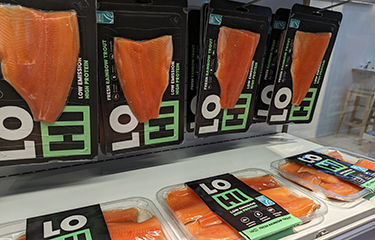Varkaus, Finland-based recirculating aquaculture system (RAS) company Finnforel launched a new brand of rainbow trout fillets it has dubbed “LOHI” (pronounced Low-high), a play on words that encompasses the company’s goals with its new product.
The name and branding – which means salmon in Finnish – also highlights the low carbon emissions and environmental impact, and high protein of the product. The company showcased the new brand at Seafood Expo Global, taking place from 25 to 27 April in Barcelona, Spain.
Finnforel Head of Technology Tommi Makinen told SeafoodSource that the final product is the result of all the company’s hard work perfecting its RAS system.
“The whole story started with the product itself,” Makinen said. “We wanted it to be a single-packed premium fillet, then we started going backwards to figure out what needs to be done.”
The new product is a 170-gram premium fillet of rainbow trout, packaged individually. The company, Makinen said, raises its fish to between 700 and 750 grams to ensure the exact fillet size it needs for the product.
Because the product is produced in a RAS facility, transit times to its markets in Finland are short, and the company can harvest and process its fish as close to sale date as possible.
“We call it ‘ultra fresh,’ because fresh doesn’t cut it any more,” Makinen said. “You order tonight, we slaughter tomorrow morning, and the trucks leave tomorrow afternoon.”
Finnforel has been steadily improving its RAS, he said, for 20 years, and began producing substantial volumes of the fish in a 1,000 metric ton (MT) facility in 2018.
“It was a disaster for the first two years,” Makinen said of the facility. “But we did a lot of fixes and designs by ourselves.”
The company continued to refine its technology, and by 2020 the company reached the “magical 90 percent efficiency,” he said. Now its facility is operating at close to 100 percent of its maximum capacity.
Makinen added that the company has proven that land-based RAS trout farming systems can be profitable, as it has “been in the black.”
“We’ve been in black figures in 2020, in the sense that we understand what it is to run a factory in its full capacity,” Makinen said.
Part of the secret to the company’s success, he said, is the “gigafactory” concept that the company uses to maximize all of its revenue streams. The company handles the fish from egg to harvest, then processes the fish into a fillet on-site. The fillets are packaged for sale, while other usable parts of the fish – guts, heads, and tail – are used for other purposes. Heads and tails go to pet food manufacturers, while the guts and the waste/sludge from the fish go to a bio-energy mill, where it is used for additional energy.
The company, Makinen said, is also piloting …
Photo by Chris Chase/SeafoodSource








